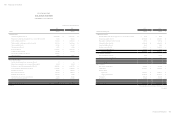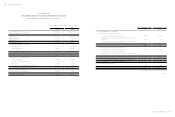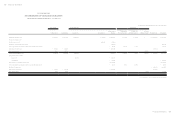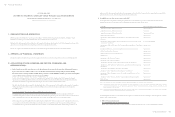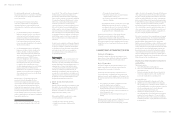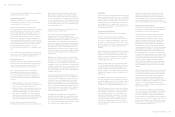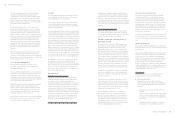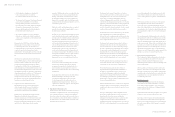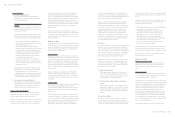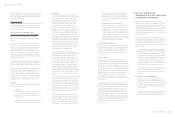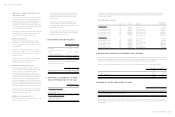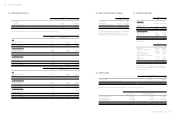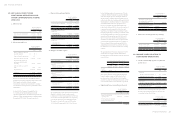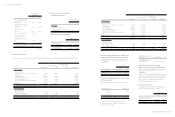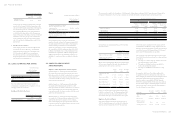HTC 2015 Annual Report Download - page 104
Download and view the complete annual report
Please find page 104 of the 2015 HTC annual report below. You can navigate through the pages in the report by either clicking on the pages listed below, or by using the keyword search tool below to find specific information within the annual report.
Financial information
Financial information
204
205
liabilities and assets reflects the tax consequences
that would follow from the manner in which the
Company expects, at the end of the reporting period,
to recover or settle the carrying amount of its assets
and liabilities.
c. Current and deferred tax for the year
Current and deferred tax are recognized in profit
or loss, except when they relate to items that are
recognized in other comprehensive income or directly
in equity, in which case, the current and deferred tax
are also recognized in other comprehensive income
or directly in equity respectively. Where current tax
or deferred tax arises from the initial accounting for a
business combination, the tax effect is included in the
accounting for the business combination.
Accrued Marketing Expenses
The Company accrues marketing expenses on the basis of
agreements and any known factors that would significantly
affect the accruals. In addition, depending on the nature
of relevant events, the accrued marketing expenses are
accounted for as an increase in marketing expenses or as a
decrease in revenues.
Treasury Share
When the Company acquires its outstanding shares that
have not been disposed or retired, treasury share is stated at
cost and shown as a deduction in stockholders' equity. When
treasury shares are sold, if the selling price is above the book
value, the difference should be credited to the capital surplus
- treasury share transactions. If the selling price is below the
book value, the difference should first be offset against capital
surplus from the same class of treasury share transactions,
and the remainder, if any, debited to retained earnings.
The carrying value of treasury share is calculated using the
weighted-average approach in accordance with the purpose of
the acquisition.
When the Company's treasury share is retired, the treasury
share account should be credited, and the capital surplus -
premium on stock account and capital stock account should
be debited proportionately according to the share ratio.
The carrying value of treasury share in excess of the sum
of its par value and premium on stock should first be offset
against capital surplus from the same class of treasury share
transactions, and the remainder, if any, debited to retained
earnings. The sum of the par value and premium on treasury
share in excess of its carrying value should be credited
to capital surplus from the same class of treasury share
transactions.
5.CRITICAL ACCOUNTING
JUDGEMENTS AND KEY SOURCES OF
ESTIMATION UNCERTAINTY
In the application of the Company's accounting policies,
which are described in Note 4, the management is required
to make judgments, estimates and assumptions about the
carrying amounts of assets and liabilities that are not readily
apparent from other sources. The estimates and associated
assumptions are based on historical experience and other
factors that are considered relevant. Actual results may differ
from these estimates.
The estimates and underlying assumptions are reviewed
on an ongoing basis. Revisions to accounting estimates are
recognized in the period in which the estimate is revised if
the revision affects only that period or in the period of the
revision and future periods if the revision affects both current
and future periods.
a. Accrued marketing and advertising expenses
The Company recognizes sale of goods as the conditions
are met. For information on the principles of revenue
recognition, please refer to Note 4 “revenue recognition”
section. The related marketing and advertising expenses
recognized as reduction of sales amount or as current
expenses are estimated on the basis of agreement, past
experience and any known factors. The Company reviews
the reasonableness of the estimation periodically.
As of December 31, 2015 and 2014, the carrying amounts
of accrued marketing and advertising expenses were
NT$13,520,221 thousand and NT$17,040,517 thousand,
respectively.
b. Allowances for doubtful debts
Receivables are assessed for impairment at the end of
each reporting period and considered impaired when
there is objective evidence that, as a result of one or more
events that occurred after the initial recognition of the
receivables, the estimated future cash flows of the asset
have been affected.
As of December 31, 2015 and 2014, the carrying amounts
of allowances for doubtful debts were NT$3,012,869
thousand and NT$3,050,907 thousand, respectively.
deficit (surplus) in the Company's defined benefit plan. Any
surplus resulting from this calculation is limited to the present
value of any refunds from the plans or reductions in future
contributions to the plans.
Termination benefits
A liability for a termination benefit is recognized at the earlier
of when the Company can no longer withdraw the offer of the
termination benefit and when the Company recognizes any
related restructuring costs.
Share-based Payment Arrangements
Share-based payment transactions of the Company
Equity-settled share-based payments to employees are
measured at the fair value of the equity instruments at the
grant date.
The fair value determined at the grant date of the equity-
settled share-based payments is expensed on a straight-
line basis over the vesting period, based on the Company's
estimate of equity instruments that will eventually vest,
with a corresponding increase in capital surplus - employee
share options. The fair value determined at the grant date
of the equity-settled share-based payments is recognized as
an expense in full at the grant date when the share options
granted vest immediately.
Restricted shares for employees are recognized as an unearned
employ's bonus on the date of grant, with a corresponding
increase in capital surplus - restricted shares for employees.
At the end of each reporting period, the Company revises its
estimate of the number of equity instruments expected to
vest. The impact of the revision of the original estimates, if
any, is recognized in profit or loss such that the cumulative
expense reflects the revised estimate, with a corresponding
adjustment to the capital surplus - employee share options
and capital surplus - restricted shares for employees.
Taxation
Income tax expense represents the sum of the tax currently
payable and deferred tax.
a. Current tax
According to the Income Tax Law, an additional tax
at 10% of unappropriated earnings is provided for as
income tax in the year the stockholders approve to
retain the earnings.
Adjustments of prior years' tax liabilities are added to
or deducted from the current year's tax provision.
b. Deferred tax
Deferred tax is recognized on temporary differences
between the carrying amounts of assets and liabilities
in the Company' parent company only financial
statements and the corresponding tax bases used
in the computation of taxable profit. Deferred tax
liabilities are generally recognized for all taxable
temporary differences. Deferred tax assets are
generally recognized for all deductible temporary
differences, unused loss carry forward and unused tax
credits for purchases of machinery, equipment and
technology, research and development expenditures,
and personnel training expenditures to the extent
that it is probable that taxable profits will be available
against which those deductible temporary differences
can be utilized. Such deferred tax assets and liabilities
are not recognized if the temporary difference arises
from goodwill or from the initial recognition (other
than in a business combination) of other assets and
liabilities in a transaction that affects neither the
taxable profit nor the accounting profit.
Deferred tax liabilities are recognized for taxable
temporary differences associated with investments
in subsidiaries and associates, and interests in
joint ventures, except where the Company is able
to control the reversal of the temporary difference
and it is probable that the temporary difference will
not reverse in the foreseeable future. Deferred tax
assets arising from deductible temporary differences
associated with such investments and interests are
only recognized to the extent that it is probable that
there will be sufficient taxable profits against which to
utilize the benefits of the temporary differences and
they are expected to reverse in the foreseeable future.
The carrying amount of deferred tax assets is reviewed
at the end of each reporting period and reduced to
the extent that it is no longer probable that sufficient
taxable profits will be available to allow all or part of
the asset to be recovered. A previously unrecognized
deferred tax asset is also reviewed at the end of each
reporting period and recognized to the to the extent
that it has become probable that future taxable profit
will allow the deferred tax asset to be recovered.
Deferred tax liabilities and assets are measured at
the tax rates that are expected to apply in the period
in which the liability is settled or the asset realized,
based on tax rates (and tax laws) that have been
enacted or substantively enacted by the end of the
reporting period. The measurement of deferred tax


